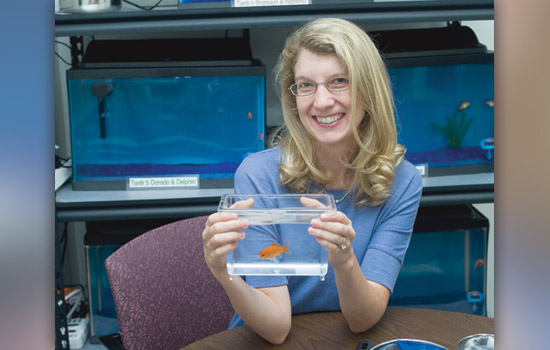Psychology professor trains goldfish
Project hopes to prove link between human, aquatic animal object constancy
A. Sue Weisler
RIT psychology professor Caroline DeLong, whose object perception research will help unlock the mysteries of aquatic animal perception, knows each of her goldfish specimens by name.
The fictitious storybook character Dr. Doolittle was known for talking with animals.
Caroline DeLong, an assistant professor of psychology at Rochester Institute of Technology, is a real-life Doolittle whose research focuses on object discrimination in goldfish and echolocation in dolphins to bring scientists closer to unlocking the mysteries of animal perception and cognition.
DeLong’s theories suggest that aquatic animals—from intelligent dolphins to pet-store goldfish with tiny brains—may recognize and represent objects similarly to humans. Specifically, they may be able to recognize an object from any orientation—called object constancy— just like humans can.
DeLong has been studying animals for about 20 years. Research by DeLong and other scientists on echolocation, or biological sonar, can help engineers create advanced software and hardware capable of underwater object recognition. Biomimetic sonar systems, based on the structure and function of animal sonar systems, outperform traditional manmade sonar systems.
“Learning about cognitive processes that dolphins engage in during echolocation can help the Navy or NASA to build a superior biomimetic system,” DeLong says.
DeLong has started a new line of research on visual object recognition using goldfish so that students can be directly involved in training animals in her lab. In a controlled environment, DeLong and her students have trained goldfish to recognize a black circle attached to the tank, and to choose that circle—even when other shapes (rectangles) are also present. The fish tap the circle with their mouths to receive a food reward. Eventually, DeLong and her students will investigate whether the fish perform the same as humans, pigeons or monkeys on tests of object constancy.
“Since I was a child, I have been fascinated by how animals communicate and view the world,” she says. “If I could magically view the world through a dolphin’s eyes for a day, I would. Humans view the world using our own sensory systems, and it’s amazing to begin to learn how all these different animals view their world using their own sensory systems.”
DeLong will soon conquer another ecosystem in her research. A partnership with Rochester’s Seneca Park Zoo will allow her to conduct visual object recognition research using semi-aquatic North American river otters.
“This partnership with the zoo will allow me to share my research with zoo visitors,” adds DeLong. “Specially designed exhibits and programs will engage zoo visitors and allow me to collect lots of interesting new data. This is a researcher’s dream project.”















